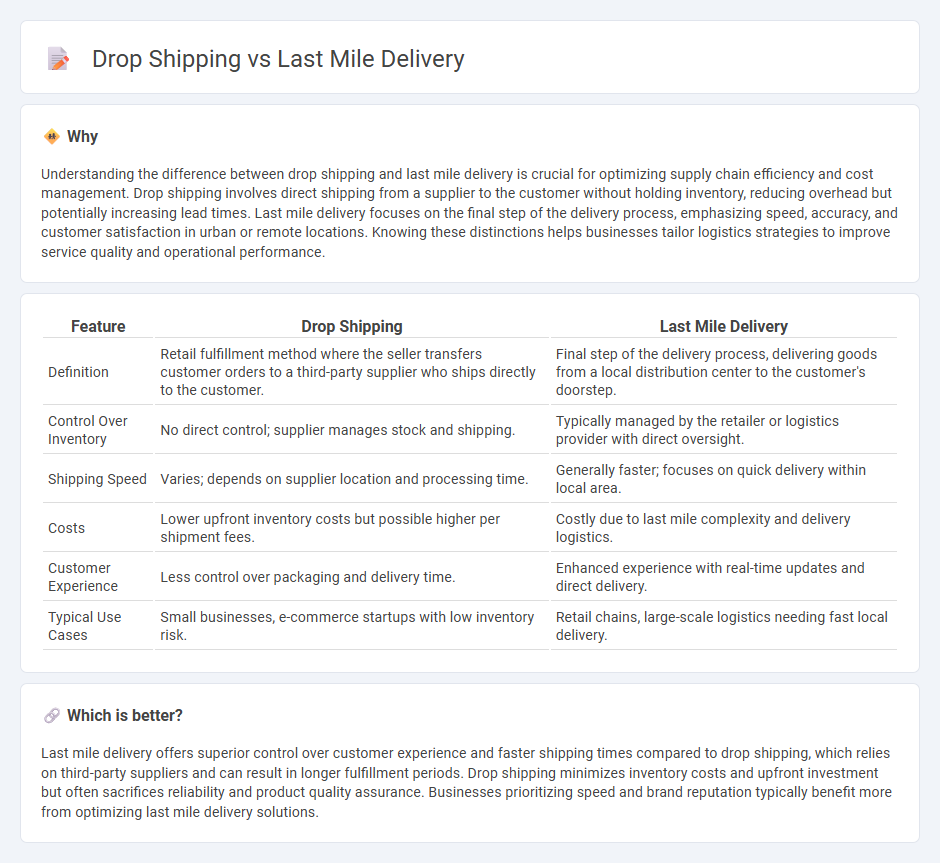
Drop shipping streamlines order fulfillment by shipping products directly from suppliers to customers without holding inventory, reducing overhead costs and increasing product variety. Last mile delivery focuses on the final step of the logistics chain, ensuring timely, efficient transport of goods from distribution centers to end consumers, enhancing customer satisfaction. Explore the key differences and benefits of drop shipping versus last mile delivery to optimize your supply chain strategy.
Why it is important
Understanding the difference between drop shipping and last mile delivery is crucial for optimizing supply chain efficiency and cost management. Drop shipping involves direct shipping from a supplier to the customer without holding inventory, reducing overhead but potentially increasing lead times. Last mile delivery focuses on the final step of the delivery process, emphasizing speed, accuracy, and customer satisfaction in urban or remote locations. Knowing these distinctions helps businesses tailor logistics strategies to improve service quality and operational performance.
Comparison Table
| Feature | Drop Shipping | Last Mile Delivery |
|---|---|---|
| Definition | Retail fulfillment method where the seller transfers customer orders to a third-party supplier who ships directly to the customer. | Final step of the delivery process, delivering goods from a local distribution center to the customer's doorstep. |
| Control Over Inventory | No direct control; supplier manages stock and shipping. | Typically managed by the retailer or logistics provider with direct oversight. |
| Shipping Speed | Varies; depends on supplier location and processing time. | Generally faster; focuses on quick delivery within local area. |
| Costs | Lower upfront inventory costs but possible higher per shipment fees. | Costly due to last mile complexity and delivery logistics. |
| Customer Experience | Less control over packaging and delivery time. | Enhanced experience with real-time updates and direct delivery. |
| Typical Use Cases | Small businesses, e-commerce startups with low inventory risk. | Retail chains, large-scale logistics needing fast local delivery. |
Which is better?
Last mile delivery offers superior control over customer experience and faster shipping times compared to drop shipping, which relies on third-party suppliers and can result in longer fulfillment periods. Drop shipping minimizes inventory costs and upfront investment but often sacrifices reliability and product quality assurance. Businesses prioritizing speed and brand reputation typically benefit more from optimizing last mile delivery solutions.
Connection
Drop shipping relies on last mile delivery to ensure products shipped directly from suppliers reach customers efficiently and on time. Effective last mile delivery solutions minimize transit times and enhance customer satisfaction in the drop shipping model. Integrating advanced tracking and route optimization technologies strengthens the connection between drop shipping and last mile logistics.
Key Terms
**Last Mile Delivery:**
Last mile delivery involves the final step of transporting goods from a distribution center directly to the customer's doorstep, emphasizing speed, accuracy, and customer experience. It leverages advanced logistics technologies like route optimization and real-time tracking to minimize delays and enhance delivery efficiency. Explore the advantages and innovations in last mile delivery to optimize your supply chain strategy.
Route Optimization
Last mile delivery emphasizes precise route optimization to minimize delivery time and costs by assigning the most efficient paths for drivers navigating multiple stops. Drop shipping relies less on route optimization since products ship directly from suppliers to customers, bypassing traditional inventory and distribution centers. Explore advanced route optimization techniques to enhance last mile delivery performance and customer satisfaction.
Proof of Delivery
Last mile delivery emphasizes direct, timely shipment to the customer's location, often integrating Proof of Delivery (POD) through digital signatures or photographic evidence to ensure transaction accuracy and customer satisfaction. Drop shipping bypasses inventory holding by having suppliers ship directly to consumers, making POD crucial for confirming receipt and reducing disputes. Explore more to understand which method best suits your supply chain needs and customer experience goals.
Source and External Links
Last mile delivery: solutions for your business | DHL Discover - Last mile delivery is the movement of goods from a transportation hub or local distribution center to the final consumer, aiming to deliver packages as affordably, quickly, and accurately as possible, often using vans, bikes, or new technologies like drones and autonomous robots.
Last Mile Delivery Logistics, Trends and Data for Retailers Explained - Last-mile delivery is the final phase of the shipping process, typically from a warehouse or distribution center to the customer's doorstep, and is considered the most expensive and time-consuming part of the supply chain, but critical for customer satisfaction and retention.
What is Last Mile Delivery? Everything You Need to Know - Onfleet - Last mile delivery refers to the transportation of parcels from a transit hub to their final destination, usually a home or retail store, and is the step where businesses focus most on speed and efficiency to meet rising consumer expectations, despite being the costliest part of the delivery journey.
 dowidth.com
dowidth.com